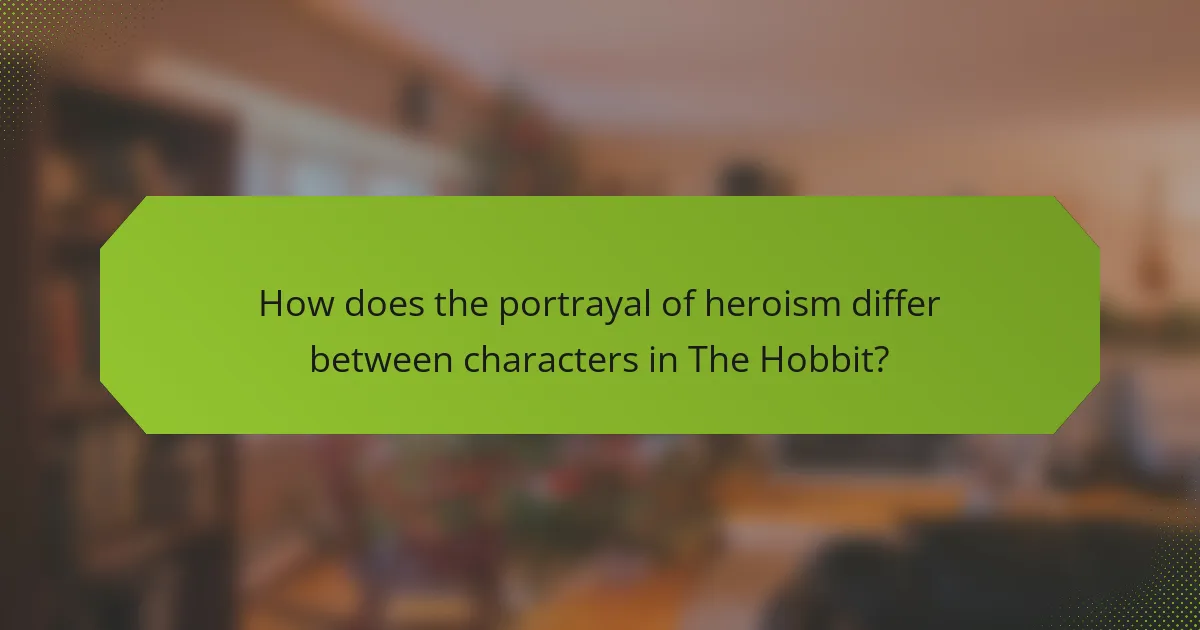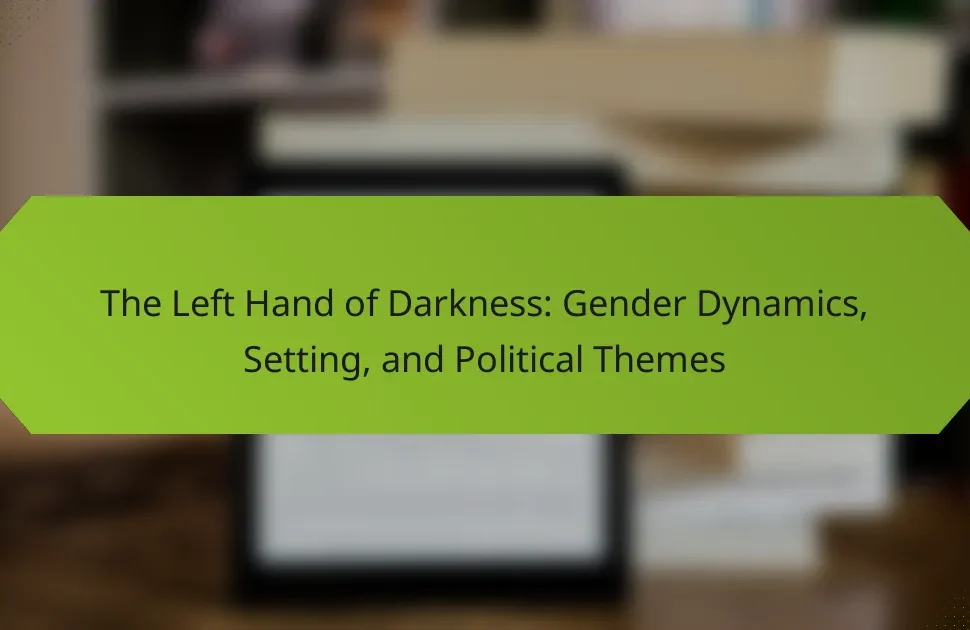The Hobbit offers profound insights into adventure, character development, and cultural influence. It illustrates Bilbo Baggins’ transformation from a timid hobbit to a courageous hero. The narrative emphasizes themes of friendship, loyalty, and the struggle between good and evil. Additionally, its lasting impact on literature and popular culture showcases the enduring relevance of Tolkien’s work.

What themes of adventure are explored in The Hobbit?
The Hobbit explores themes of adventure including personal growth, bravery, and the quest for identity. Bilbo’s journey transforms him from a cautious hobbit into a resourceful hero. The adventure highlights the importance of friendship, loyalty, and the struggle between good and evil. This narrative reflects cultural values and the hero’s journey, showcasing how challenges shape character.
How does Bilbo’s journey exemplify the hero’s journey archetype?
Bilbo’s journey exemplifies the hero’s journey archetype through stages of transformation and self-discovery. He begins as an ordinary hobbit, reluctant to leave his comfort zone, representing the “ordinary world” stage. The call to adventure arrives when Gandalf and the dwarves invite him on a quest.
Bilbo faces trials that challenge his courage and resourcefulness. For example, he confronts trolls, goblins, and Smaug, showcasing his growth through adversity. His unique attribute lies in his cleverness, which ultimately aids in overcoming obstacles.
The journey culminates in a return home, where Bilbo emerges transformed, embodying the “return with the elixir” stage. His experiences influence his character development and cultural impact, illustrating the timeless nature of the hero’s journey.
What role do the different landscapes play in the adventure narrative?
Different landscapes significantly shape the adventure narrative in “The Hobbit.” Each setting influences character development, plot progression, and thematic elements.
The Shire represents comfort and innocence, contrasting with the dangers of the Misty Mountains and Mirkwood. These treacherous terrains challenge Bilbo, forcing growth and resilience.
The Lonely Mountain symbolizes the ultimate quest, embodying the culmination of adventure and the pursuit of treasure. This landscape reflects the themes of greed and redemption, impacting character motivations.
Ultimately, the diverse landscapes create a rich backdrop that enhances the narrative’s depth, illustrating the transformative journey of the protagonist.

How does character development manifest in The Hobbit?
Character development in The Hobbit is evident through Bilbo Baggins’ transformation from a timid hobbit to a courageous hero. His journey illustrates growth in bravery, resourcefulness, and leadership. Initially, Bilbo is reluctant to leave his comfortable home, but as the adventure unfolds, he faces numerous challenges that shape his character.
Key moments, such as outsmarting trolls and confronting Smaug, highlight his evolving confidence. Bilbo’s unique attribute is his ability to think creatively under pressure. His encounters with diverse characters, including Gandalf and the dwarves, further influence his development.
The cultural impact of Bilbo’s character arc resonates with themes of personal growth and adventure, inspiring readers to embrace their own journeys of self-discovery. Overall, character development in The Hobbit serves as a compelling narrative device that enriches the story’s depth and meaning.
What transformations does Bilbo undergo throughout the story?
Bilbo undergoes significant transformations throughout “The Hobbit,” evolving from a timid hobbit into a courageous adventurer. Initially, he is reluctant to leave his comfortable home, but as the journey progresses, he gains confidence and resourcefulness.
His encounters with various creatures, such as trolls, goblins, and Smaug, challenge him and foster personal growth. Bilbo’s acquisition of the One Ring symbolizes his evolving identity, granting him both power and moral dilemmas. By the end, he emerges as a hero, showcasing bravery and wisdom, profoundly impacting both his world and his own character.
How do the supporting characters contribute to Bilbo’s growth?
Supporting characters significantly shape Bilbo’s growth throughout “The Hobbit.” Characters like Gandalf, Thorin, and Smaug challenge him and catalyze his transformation from a timid hobbit into a courageous hero. Gandalf’s wisdom encourages Bilbo to embrace adventure, while Thorin’s leadership and struggles teach him about bravery and loyalty. Smaug, as the antagonist, forces Bilbo to confront his fears, ultimately revealing his resourcefulness. This dynamic interplay with supporting characters highlights Bilbo’s evolving identity and underscores the theme of personal growth in the narrative.

Which cultural impacts has The Hobbit had since its publication?
The Hobbit has significantly influenced culture through its themes of adventure, character development, and world-building. Its impact is evident in literature, film, and popular culture.
The narrative has inspired countless adaptations, including animated films and live-action series. The character of Bilbo Baggins represents the archetypal hero’s journey, resonating with audiences and influencing storytelling conventions.
Moreover, the rich mythology created by J.R.R. Tolkien has shaped modern fantasy literature, establishing a foundation for subsequent works. The Hobbit’s exploration of friendship, courage, and personal growth continues to inspire readers and creators alike.
Cultural references to The Hobbit appear in various media, demonstrating its lasting relevance. For instance, phrases like “There and back again” have entered popular vernacular, reflecting the story’s enduring legacy.
How has The Hobbit influenced modern fantasy literature?
The Hobbit has profoundly influenced modern fantasy literature by establishing key narrative elements and world-building techniques. Its adventure-driven plot and rich character development set a precedent for subsequent works.
The journey of Bilbo Baggins reflects a classic hero’s journey, inspiring countless authors to explore themes of growth and transformation. The detailed world of Middle-earth introduced readers to intricate cultures, languages, and histories, encouraging a deeper immersion in fantasy realms.
Additionally, The Hobbit’s blend of humor, adventure, and moral lessons resonates with readers, shaping the tone and style of modern fantasy. Its impact is evident in works by authors like J.K. Rowling and George R.R. Martin, who draw from Tolkien’s legacy in character complexity and expansive world-building.
Overall, The Hobbit remains a cornerstone of the genre, influencing narrative structure, character arcs, and thematic depth in contemporary fantasy literature.
What adaptations of The Hobbit have shaped its cultural perception?
Adaptations of The Hobbit, including films, animations, and stage productions, have significantly shaped its cultural perception by enhancing its themes and character depth. The 2001 film adaptation by Peter Jackson introduced a wider audience to the rich world of Middle-earth, emphasizing adventure and friendship. The animated version from 1977 contributed to early interpretations of the story, influencing perceptions of fantasy in media. Additionally, stage adaptations have allowed for diverse interpretations, showcasing the narrative’s adaptability. Each adaptation highlights unique attributes, such as visual storytelling and character development, reinforcing the story’s enduring impact on popular culture.

What are the key attributes of character relationships in The Hobbit?
The key attributes of character relationships in The Hobbit include loyalty, growth, and conflict. Characters like Bilbo and Gandalf exemplify loyalty, as their bond strengthens throughout the journey. Bilbo’s growth from a timid hobbit to a courageous hero showcases significant character development. Conflict arises between characters, such as Thorin’s pride and Bilbo’s pragmatism, driving the narrative forward. These attributes enrich the story’s depth and impact.
How do friendship and loyalty evolve among the characters?
Friendship and loyalty evolve significantly among the characters in “The Hobbit.” Bilbo Baggins transforms from a cautious hobbit to a brave companion, earning the respect and loyalty of the dwarves. Thorin Oakenshield’s initial distrust shifts to a deep bond with Bilbo, showcasing loyalty forged through shared challenges. The dynamics between characters reveal how adversity strengthens friendship, as seen in their collective battles against trolls, goblins, and Smaug. This evolution illustrates the theme of camaraderie, emphasizing that loyalty often emerges from mutual respect and shared experiences.
What conflicts arise from differing character motivations?
Conflicts arise from differing character motivations in “The Hobbit” as they drive tension and narrative progression. For instance, Bilbo’s desire for adventure clashes with Thorin’s quest for treasure. This contrast shapes character development and impacts relationships. Additionally, Smaug’s greed introduces external conflict, highlighting the themes of ambition and morality. These motivations create a rich tapestry of interactions that enhance the story’s depth.

How does the portrayal of heroism differ between characters in The Hobbit?
The portrayal of heroism in The Hobbit varies significantly among characters. Bilbo Baggins embodies reluctant heroism through his growth from a timid hobbit to a courageous leader. Thorin Oakenshield represents traditional heroism, driven by honor and the quest for his homeland. In contrast, characters like Gollum highlight anti-heroism, showcasing moral ambiguity and the struggle against inner demons. These differing portrayals reflect cultural values and the complexity of heroism in literature.
What makes Bilbo’s brand of heroism unique compared to traditional heroes?
Bilbo’s brand of heroism is unique due to his ordinary background and gradual character development. Unlike traditional heroes, he embodies relatability and growth through adversity. Bilbo starts as a timid hobbit but evolves into a resourceful leader. His journey emphasizes courage over physical prowess and highlights the importance of cleverness and resilience. This transformation resonates with readers, making his heroism accessible and inspiring.
How do the dwarves’ perspectives on heroism contrast with Bilbo’s?
The dwarves view heroism through a lens of loyalty and bravery, contrasting sharply with Bilbo’s more pragmatic and reluctant approach. Dwarves, shaped by their cultural heritage, often equate heroism with valor in battle and unwavering loyalty to kin. For them, acts of bravery are vital to reclaiming their homeland and treasures. In contrast, Bilbo embodies a unique attribute of heroism that prioritizes cleverness and resourcefulness over physical prowess. His journey reflects personal growth, as he learns that true heroism can also involve subtlety and intelligence, not just swordsmanship. This divergence highlights the rich cultural tapestry within “The Hobbit,” showcasing how different backgrounds influence perceptions of heroism.

What lessons can be learned from the character arcs in The Hobbit?
The character arcs in The Hobbit teach lessons about personal growth, bravery, and the importance of friendship. Bilbo Baggins transforms from a hesitant hobbit into a courageous hero, showcasing resilience. Thorin Oakenshield’s journey reflects the dangers of pride and the value of humility. The interactions among the characters highlight the significance of loyalty and teamwork in overcoming challenges. These themes resonate culturally, encouraging readers to reflect on their own personal development and relationships.
How can readers apply Bilbo’s lessons to their own lives?
Readers can apply Bilbo’s lessons by embracing courage, valuing friendship, and seeking personal growth. Bilbo’s journey illustrates the importance of stepping outside comfort zones. He transforms from a timid hobbit into a brave hero, showcasing character development through challenges. This narrative encourages readers to face their fears and pursue adventures in their own lives. Additionally, the bonds Bilbo forms with others highlight the significance of relationships and collaboration. By reflecting on these themes, readers can foster resilience and build meaningful connections, ultimately enriching their life experiences.
What common mistakes should be avoided in character development based on The Hobbit?
Avoiding common mistakes in character development in The Hobbit is crucial for effective storytelling. Key pitfalls include neglecting character arcs, failing to establish clear motivations, and underutilizing supporting characters.
1. Overlooking character growth can lead to static roles, diminishing the impact of the journey.
2. Ignoring motivations may cause characters to appear unrealistic or inconsistent.
3. Underdeveloping supporting characters can weaken the narrative and limit engagement.
Ensuring characters evolve, have clear goals, and interact meaningfully enhances the overall adventure and cultural significance of the story.




